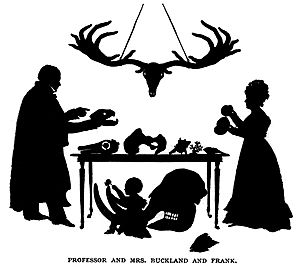William Buckland facts for kids
Quick facts for kids The Reverend William Buckland FRS |
|
|---|---|
| Dean of Westminster | |
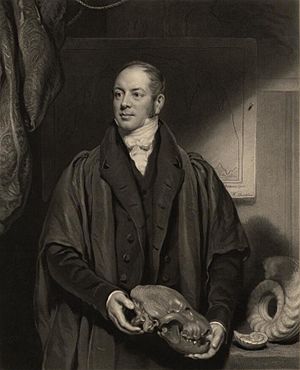
Buckland in 1833
|
|
| Personal details | |
| Born | 12 March 1784 Axminster, Devon, England |
| Died | 14 August 1856 (aged 72) Islip, Oxfordshire, England |
| Denomination | Anglican |
| Spouse | |
| Alma mater | Winchester College, Corpus Christi College, Oxford |
William Buckland (born March 12, 1784 – died August 14, 1856) was an English scientist and religious leader. He became the Dean of Westminster, a high position in the Church of England. He was also a very important geologist (someone who studies Earth's rocks) and palaeontologist (someone who studies fossils).
Buckland was the first to fully describe a fossil dinosaur. He named it Megalosaurus. He also proved that Kirkdale Cave in North Yorkshire was once a den for ancient hyenas. For this work, he won the Copley Medal, a major science award. His research showed how scientists could figure out what happened long ago. He also started using fossilized animal waste, called coprolites, to understand ancient environments.
Buckland tried to connect his scientific discoveries with the Bible. He believed that the Earth was very old, which fit with new ideas in geology. Early on, he thought he found proof of the biblical flood. But later, he realized that the glaciation theory (about huge ice sheets) explained things better. He then helped spread this new idea.
Early Life and Education
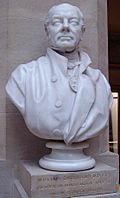
William Buckland was born in Axminster, England. As a child, he often went on walks with his father, who was a priest. His father was interested in improving roads. This led them to collect fossil shells, like ammonites, from local rock quarries. These fossils came from the Jurassic period.
He went to Blundell's School and then Winchester College. He earned a scholarship to Corpus Christi College, Oxford. He studied there and became interested in geology after attending lectures on minerals and chemistry. During his school breaks, he explored different rock layers. He earned more degrees and became a Fellow at Corpus Christi. He also became a priest. He kept traveling around England, Scotland, Ireland, and Wales to study geology.
In 1813, Buckland became a professor of mineralogy at Oxford. He gave exciting lectures that focused more and more on geology and palaeontology. He also helped build up the collections at the Ashmolean Museum. He traveled in Europe and met other famous scientists, like Georges Cuvier.
Discoveries and Scientific Work
Understanding Ancient Caves
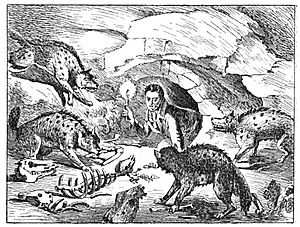
In 1818, Buckland became a member of the Royal Society, a top scientific group. He convinced the Prince Regent to create a new professorship for geology at Oxford. Buckland became the first geology professor in 1819. He gave a speech that explained how geology could fit with religious beliefs.
At first, Buckland believed in a worldwide flood, like Noah's Flood in the Bible. He thought this flood had shaped some of Earth's features. But he also believed the Earth was very old, with many changes over time. He thought only a small amount of rock layers could have formed during a short flood.
He studied Kirkdale Cave in Yorkshire. He found many fossil bones there. He realized the cave was not filled by a flood. Instead, it was a den where ancient hyenas lived. The bones were from the hyenas and the animals they ate. This was different from what he and others first thought. They had believed the bones were from animals that died in a flood and were carried from far away.
Buckland's work on Kirkdale Cave was praised. It showed how careful study could reveal Earth's past. The Royal Society gave him the Copley Medal in 1822 for his paper on the cave.
Even though he realized the bones weren't from a flood, Buckland still thought a thin layer of mud in the cave was from a "Universal Deluge." He wrote a popular book about it in 1823. But as geology advanced, he changed his mind again. By 1836, he admitted that geology could not prove Noah's Flood. By 1840, he was actively promoting the idea that huge ice sheets (glaciers) had caused many of the features he once thought were from a flood.
Discovering Megalosaurus
Buckland became the president of the Geological Society of London in 1824. He announced the discovery of giant reptile bones at Stonesfield. He named this creature Megalosaurus, meaning 'great lizard'. This was the first full description of what we now call a dinosaur.
In 1825, he was elected to the American Academy of Arts and Sciences. He also became a Canon of Christ Church, Oxford. This was a good position that allowed him to continue his academic work.
His Marriage and Family
In December 1825, William Buckland married Mary Morland. Mary was a talented artist and fossil collector. Their honeymoon was a year-long trip around Europe, visiting famous geologists and fossil sites. Mary helped him with his work throughout their marriage. They had nine children, and five lived to adulthood. Their son, Frank Buckland, became a famous naturalist.
Mary even helped William solve a scientific puzzle. They used their pet tortoise to figure out ancient footprints found in sandstone. William's daughter, Elizabeth Oke Buckland Gordon, later wrote a book about her father's life.
The Red Lady of Paviland
In 1823, Buckland found a human skeleton in Paviland Cave in Wales. He called it the Red Lady of Paviland. He found it near bones of extinct animals like mammoths. However, at the time, scientists didn't believe humans lived alongside these ancient animals. So, Buckland thought the skeleton was buried much later, by people who dug into older layers of earth.
Later tests showed that the skeleton, which was actually male, is about 33,000 years old. It is the oldest known modern human skeleton found in the United Kingdom.
Coprolites and Ancient Food Chains
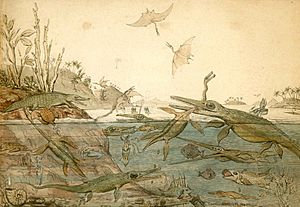
The fossil hunter Mary Anning noticed strange stony objects near ichthyosaur skeletons. These objects, called "bezoar stones," were often found where the stomach would be. When broken open, they contained fossilized fish bones and scales.
Mary Anning's observations led Buckland to suggest in 1829 that these stones were fossilized animal waste (poop). He gave them the name coprolites. This name is now used for all fossilized animal waste.
Buckland also noticed spiral patterns on some coprolites. He thought this meant ichthyosaurs had spiral intestines, like modern sharks. He also found that some coprolites were black because the ichthyosaur had eaten belemnites (ancient squid-like creatures) that had ink sacs. He wrote a detailed description of the ancient food chain based on these findings. This inspired artist Henry De la Beche to paint Duria Antiquior. This was the first picture showing a scene from the distant past. Buckland used copies of this painting in his lectures.
Buckland also helped other geologists. He suggested a good place for Roderick Murchison to start his research in South Wales. Murchison later named these older rock layers Silurian. In 1832, Buckland led the second meeting of the British Association for the Advancement of Science.
Bridgewater Treatise and Glaciation
Buckland was asked to write one of eight "Bridgewater Treatises." These books aimed to show God's power and wisdom through creation. His book, published in 1836, was called Geology and Mineralogy considered with reference to Natural Theology. In it, he explained his ideas about how Earth's history and the fossil record fit with religious beliefs. He suggested that God created life in stages, preparing Earth for humans.
After Charles Darwin returned from his Beagle journey, Buckland discussed his findings with him. Buckland later recommended Darwin's paper on earthworms and soil formation for publication. He called it a "new & important theory."
Buckland became a well-known scientist and friend of the Prime Minister, Sir Robert Peel. He helped set up the Geological Survey of Great Britain.
He became interested in the idea from Louis Agassiz that ancient glaciers had caused polished rocks and moved material. In 1838, he traveled to Switzerland to meet Agassiz and see the evidence. He was convinced. He realized that features he had seen in Scotland, Wales, and northern England, which he once thought were from a flood, were actually caused by glaciers. When Agassiz visited Britain in 1840, they toured Scotland and found more proof of past glaciation. Buckland, as president of the Geological Society, promoted this idea, even though some members were against it at first.
In 1845, he became the Dean of Westminster. He was also given the church position of Islip. As Dean, Buckland helped with the care of Westminster Abbey. He also continued to teach geology at Oxford. In 1847, he became a trustee of the British Museum. In 1848, he received the Wollaston Medal for his geological work.
Later Life and Legacy
Around 1850, William Buckland became ill with a brain disorder. He died in 1856.
A funny story is told about his burial. His grave plot was chosen, but when the gravedigger started, he hit solid Jurassic limestone. They had to use explosives to dig the grave! This was a fitting end for a famous geologist who loved rocks. A poem written about him in 1820 joked about this:
Where shall we our great Professor inter
That in peace may rest his bones?
If we hew him a rocky sepulchre
He'll rise and break the stones
And examine each stratum that lies around
For he's quite in his element underground
Interesting Habits
Buckland often wore his academic gown while doing his field work. His lectures were very lively. He would even act out the movements of dinosaurs when talking about them! His passion for science extended to his home. He had a table with dinosaur coprolites (fossilized poop) inlaid into it. You can still see the original table top at the Lyme Regis Museum.
His home was full of specimens, both living and dead. He also claimed to have eaten his way through the animal kingdom! He tried eating many different animals. Some of the least tasty were mole and bluebottle fly. He also ate panther, crocodile, and mouse. His son, Frank Buckland, continued this unusual hobby. Once, William Buckland even ate a piece of the mummified heart of King Louis XIV!
Honors and Memorials
A wrinkle ridge on the Moon is named Dorsum Buckland after him. Buckland Island (now called Ani-Jima) was also named in his honor in 1827. In Islip, where he was a rector, there is a plaque in the church and a window dedicated to him and his wife. Another plaque is near his summer home in Islip. There is also a statue of him at Westminster Abbey.
In 1972, a genus of moss, Bucklandiella, was named after him. The Buckland Peaks in New Zealand's Paparoa Range also bear his name.
See also
 In Spanish: William Buckland para niños
In Spanish: William Buckland para niños


